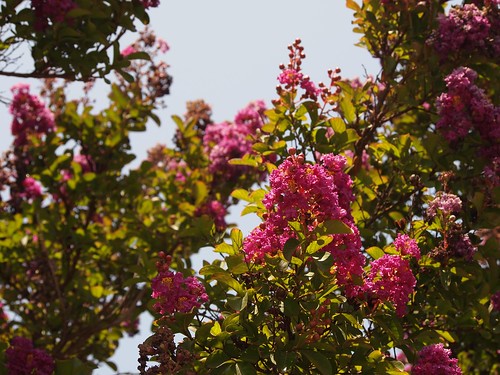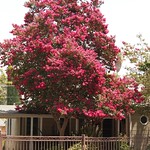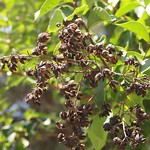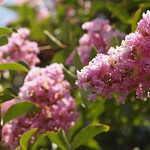In the neighborhood is a collection of video and photographs gathered here in my own Southern California neighborhood. What’s happening in your neighborhood. Share some of your photos with AGN readers and myself in the comments.
In the neighborhood…Crape Myrtle (Lagerstroemia)
It is obviously the time of the year when the Crape Myrtle bloom prolifically here in Southern California. Crape Myrtle are ubiquitous trees in lawns, gardens and tree lawns (those strips between the sidewalk and the street) here in Los Angeles. They are relatively slow growing, look good even when not in flower and yet flower exuberantly at this time of year.
See the entire series of crape myrtle photos in this Flickr Set
In this collection of photos from my neighborhood walk today, you will see colors ranging from deep reds, to corals and pinks to dark, striking purples. My timing for photography was not the best, being quite near high noon, so some of the colors are a bit washed out due to the strong sun. In your own garden or lawn you will be surprised at the amazing contrast between the blooms, the dark green leaves and the other green plants in your garden.
Crape Myrtle is deciduous, even here in Southern California, and goes bare each Winter. That is the time when you should prune the trees, removing growth smaller than a standard No. 2 pencil in thickness. It appears that the tree flowers on new growth, so a light pruning will help to promote this new growth and hence, more flowers.
As you will see in the photos, here in Los Angeles, Crape Myrtles are pruned as trees, rather than bushes, as they are in some other areas. This is also probably due to the varieties that are typical in the local nurseries. If you are looking for a more “shrubby” plant, you should be able to find that with a little research. Regardless of how you grow it, though, remember to pick a cultivar that suits the space where you plan on growing it. No plant does well when it has to be heavily pruned just to keep it in-bounds.
Crape Myrtle (Lagerstroemia)
“Lagerstroemia /ˌleɪɡərˈstriːmiə/,[1] commonly known as crape myrtle or crepe myrtle, is a genus of around 50 species of deciduous andevergreen trees and shrubs native to the Indian Subcontinent, southeast Asia, northern Australia and parts of Oceania, cultivated in warmer climates around the world. It is a member of the Lythraceae, which is also known as the loosestrife family. The genus is named after the Swedish merchant Magnus von Lagerström, who supplied Carolus Linnaeus with plants he collected. These flowering trees are beautifully colored and are often planted both privately and commercially. Popular varieties used in modern landscaping include the bright red Dynamite Crape Myrtle, the deep pink Pink Velour Crape and the purple Twilight Crape Myrtle, which also has a bark that changes colors.” — Wikipedia
More information on Daylily (Hemerocallis):
- Lagerstroemia on Wikipedia
- Lagerstroemia on Clemson Cooperative Extension
- Crepe Myrtle Pruning Step-by-Step on Southern Living
Previously in In the neighborhood…




